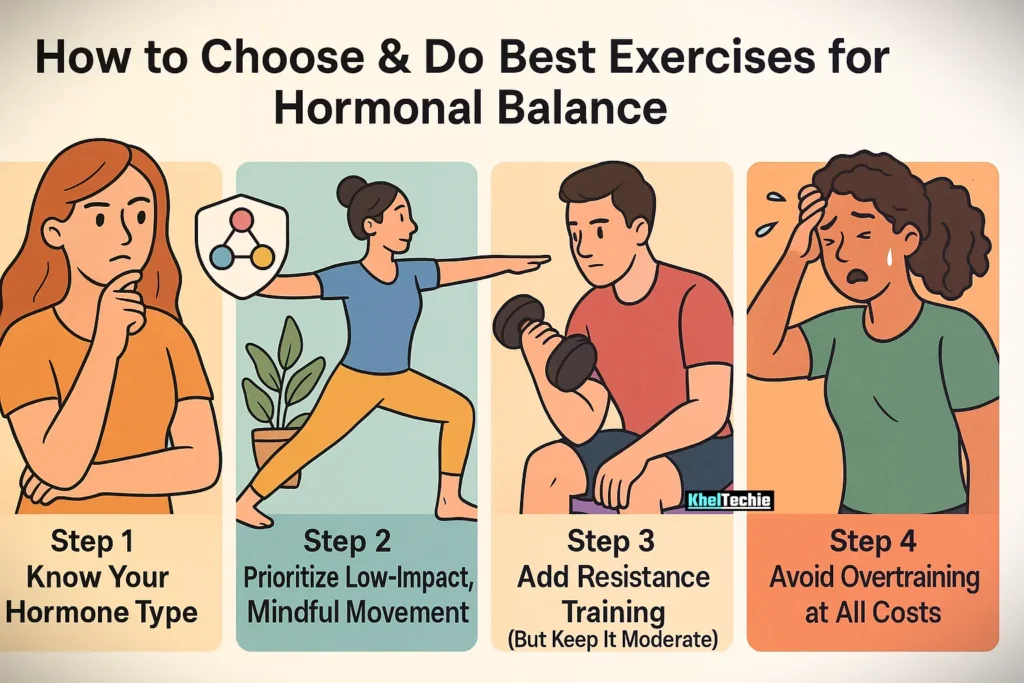The Best Exercises for Hormonal Balance: Transform Your Health from the Inside Out
Are You Battling Fatigue, Mood Swings, or Weight Gain?
If you’ve ever felt like your body is working against you, cravings out of control, sleepless nights, emotional rollercoasters, it might not be just stress. These could be signs of hormonal imbalance, a common but often overlooked issue affecting millions worldwide.
The good news? You don’t need to rely solely on medication or drastic diets. There’s a natural, empowering solution: Exercise. But not just any workout will do. The key lies in choosing the best exercises for hormonal balance, those that support your endocrine system without pushing it into overdrive.
In this article, we’ll walk you through the most effective workouts, backed by science and real-life experiences, to help you reclaim your hormonal health and feel like yourself again.
Also read – Strength Training for Women Over 40

What Exactly Are the Best Exercises for Hormonal Balance?
Hormones are chemical messengers in your body that regulate everything from mood and metabolism to reproductive health and immune function. When they’re out of sync, whether due to chronic stress, poor diet, lack of sleep, or sedentary lifestyle, you may experience symptoms like:
- Chronic fatigue
- Anxiety or depression
- Irregular menstrual cycles
- Insulin resistance
- Thyroid dysfunction
- Unexplained weight gain or loss
Now, how does exercise come into play?
Not all physical activity is created equal when it comes to hormones. While some types of exercise can reduce cortisol (the stress hormone) and boost feel-good hormones like serotonin and dopamine, others, especially high-intensity or excessive workouts—can worsen imbalances.
So, the best exercises are those that promote hormonal harmony, not chaos.
Why Hormonal Balance Matters More Than You Think
According to the Mayo Clinic, during a Q&A session one of its answers reflect that hormonal imbalances affect nearly 1 in 8 women with conditions like PCOS (Polycystic Ovary Syndrome), hypothyroidism, and adrenal fatigue. Men aren’t immune either, low testosterone and insulin resistance are rising concerns.
And while modern medicine offers solutions, many people are turning to lifestyle interventions like exercise to manage these issues holistically.
Real-Life Impact
My cousin Brenda, a 34-year-old teacher who struggled with anxiety, irregular periods, and constant fatigue. After integrating yoga and moderate strength training into her routine, she reported better sleep, fewer cravings, and a more stable mood within six weeks.
Her story isn’t unique.
Exercise acts as a natural regulator of the hypothalamic-pituitary-adrenal (HPA) axis, the brain-body connection responsible for managing stress and hormone production.

How to Choose & Do the Best Exercises for Hormonal Balance
Here’s your roadmap to selecting and performing the most effective workouts based on your body’s needs.
Step 1: Know Your Hormone Type
Different hormones respond differently to exercise:
| Hormone | Exercise Response |
|---|---|
| Cortisol | Decreased with low-to-moderate intensity |
| Insulin | Improved sensitivity with resistance training |
| Estrogen/Testosterone | Balanced with consistent, moderate movement |
| Thyroid Hormones | Regulated with regular, gentle activity |
If you’re dealing with adrenal fatigue or high cortisol, avoid long cardio sessions and opt for shorter, calming workouts.
Step 2: Prioritize Low-Impact, Mindful Movement
These exercises are gentle on the body but powerful for hormonal regulation.
(i). Yoga
- Why It Works: Reduces cortisol, increases GABA (a calming neurotransmitter), and improves thyroid function.
- Best Types: Hatha, Yin, Restorative Yoga
- How Often: 3–5 times per week for 30+ minutes
(ii). Walking
- Why It Works: Boosts endorphins, supports insulin sensitivity, and encourages lymphatic flow.
- How Often: Daily, aim for 30–60 minutes at a conversational pace
(iii). Pilates
- Why It Works: Builds core strength, improves posture, and reduces stress-related tension.
- How Often: 2–4 times per week
(IV). Tai Chi / Qigong
- Why It Works: Combines breathwork and slow movement to calm the nervous system.
- How Often: 2–3 times per week
Step 3: Add Resistance Training (But Keep It Moderate)
Strength training helps build lean muscle mass, which boosts metabolic rate and stabilizes blood sugar, key for balancing insulin and sex hormones.
A well crafted Weekly Routine should look like :
| Day | Workout |
|---|---|
| Monday | Yoga + Light Weights |
| Wednesday | Pilates + Walking |
| Friday | Strength Circuit (Bodyweight or Dumbbells) |
| Sunday | Tai Chi or Walk |
Use lighter weights and higher reps (12–15 reps) to avoid overstimulation.
Step 4: Avoid Overtraining at All Costs
Excessive cardio or HIIT can spike cortisol and disrupt your hormonal rhythm.
🚫 Red Flags of Overtraining:
- Persistent fatigue
- Poor sleep
- Mood swings
- Missed periods
- Elevated resting heart rate
If you’re gasping for air during a workout, it’s too intense for hormonal healing.
Common Mistakes to Avoid When Exercising for Hormonal Balance
Even with the best intentions, many people unknowingly sabotage their progress. Here are the top mistakes and how to fix them.
❌ Mistake #1: Doing Too Much, Too Fast
Jumping into intense workouts without building a foundation can cause burnout and worsen hormonal imbalances.
✅ Fix: Start slow. Focus on consistency over intensity.
❌ Mistake #2: Ignoring Sleep & Nutrition
Exercise alone won’t fix hormonal issues if you’re sleep-deprived or eating processed foods.
✅ Fix: Prioritize 7–9 hours of quality sleep and nourish your body with whole foods rich in magnesium, zinc, and omega-3s.
❌ Mistake #3: Skipping Recovery Days
Your body heals during rest, not just during workouts.
✅ Fix: Schedule at least one full rest day and incorporate stretching or foam rolling.
❌ Mistake #4: Comparing Yourself to Others
Everyone’s hormonal profile is different. What works for your friend may not work for you.
✅ Fix: Listen to your body. Adjust workouts based on how you feel—not what someone else is doing.
Conclusion: Reclaim Your Hormonal Health Through the Right Movement
You now know the best exercises for hormonal balance and how to implement them safely and effectively.
From calming yoga flows to mindful walks and smart strength training, each move you make brings you closer to feeling your best, naturally.
Remember, this isn’t about perfection. It’s about progress, patience, and listening to your body. Whether you’re managing PCOS, menopause, or daily stress, the right kind of movement can transform your hormonal health from the inside out.
So, lace up your shoes, roll out your mat, or simply step outside and start walking.
Your hormones and your future self will thank you.
📣 Share Your Story!
Have you tried any of these exercises for hormonal balance? Did something surprise you? Leave a comment below or share your journey, we’d love to hear from you!
📌 Don’t forget to share this guide with anyone who might benefit from it. Together, we can empower more people to heal naturally.
Frequently Asked Questions
What Hormones Does Exercise Affect the Most?
Exercise impacts several key hormones:
Thyroid Hormones: T3 and T4 levels can improve with regular, gentle exercise.
Cortisol: Stress hormone; reduced with moderate activity.
Insulin: Helps regulate blood sugar; improved with resistance training.
Endorphins: Natural painkillers and mood boosters.
Estrogen/Progesterone/Testosterone: Sex hormones regulated through balanced movement.
Can Strength Training Help With Hormonal Imbalance?
Yes! Strength training builds lean muscle, which enhances insulin sensitivity and supports healthy estrogen and testosterone levels.
However, moderation is key—excessive lifting or overtraining can have the opposite effect.
Is Yoga Really Effective for Balancing Hormones?
Absolutely. Studies show yoga significantly lowers cortisol and increases GABA, helping to alleviate symptoms of anxiety, insomnia, and hormonal fluctuations.
A 2011 study published in The Journal of Alternative and Complementary Medicine found that participants who practiced yoga regularly experienced lower stress and better mood regulation.
Should I Avoid Cardio If I Have Hormonal Imbalance?
Not necessarily—but choose wisely.
Low-impact cardio like walking, cycling, or swimming can be beneficial. However, long-distance running or excessive HIIT can elevate cortisol and worsen imbalances.
Stick to 30–45 minutes of moderate cardio 2–3 times per week.
How Often Should I Exercise for Hormonal Balance?
Aim for 3–5 days per week, combining:
- 2–3 days of mindful movement (yoga, tai chi)
- 1–2 days of strength training
- 1–2 days of light cardio (walking, cycling)
Always include rest days to allow your body to recover.
Can These Exercises Help With PCOS or Menopause Symptoms?
Yes! For PCOS, moderate exercise improves insulin sensitivity and regulates menstrual cycles.
For menopause, strength training helps maintain bone density, while yoga and walking ease hot flashes and mood swings.
Always consult with a healthcare provider before starting a new fitness regimen, especially if you have a medical condition.
Does Exercise Affect Hormones Like Estrogen and Testosterone?
Yes, but in a nuanced way.
Regular, moderate exercise supports healthy estrogen and testosterone levels. However, extreme exercise can lower testosterone in men and disrupt ovulation in women.
Balance is key.
Should I Consult a Doctor Before Starting These Exercises?
If you have a known hormonal disorder (e.g., thyroid disease, Cushing’s syndrome, or Addison’s disease), it’s wise to consult a doctor or endocrinologist before beginning any new exercise program.
They can help tailor workouts to your specific needs.
What Role Does Diet Play Alongside These Exercises?
Diet and exercise go hand-in-hand.
To maximize hormonal benefits from your workouts:
Eat anti-inflammatory foods: leafy greens, fatty fish, nuts, seeds
Avoid refined sugars and processed foods
Stay hydrated
Ensure adequate protein intake for muscle repair
Consider supplements like magnesium, vitamin D, and omega-3s after consulting a professional
How Long Does It Take to See Results?
Most people notice improvements in mood, sleep, and energy within 4–6 weeks of consistent, balanced exercise.
Full hormonal regulation may take 3–6 months, depending on individual factors like diet, stress levels, and pre-existing conditions.





Pingback: Best Iron-Rich Foods For Anemia That Boost Energy Fast
Pingback: Top 10 Best Healthy Desserts For Fitness Enthusiasts